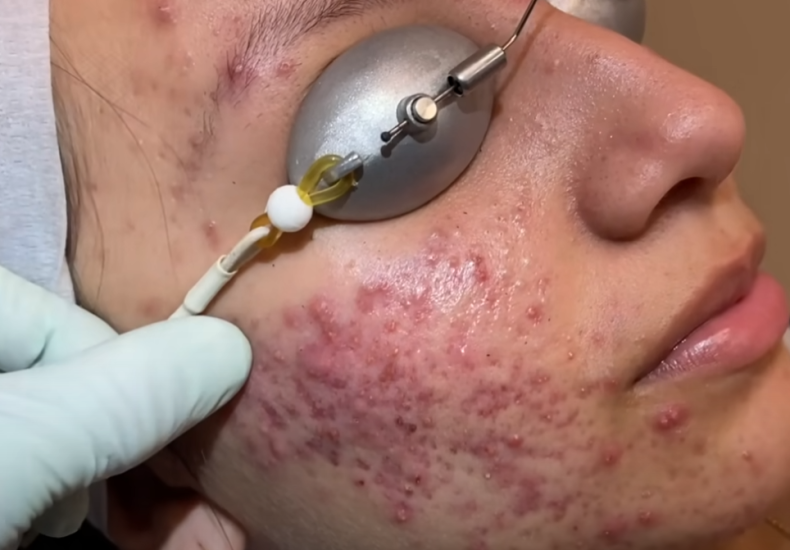If you’re asking how to do acne extractions on severe inflammatory acne (the kind that’s red, swollen, and often painful), here’s the honest breakdown:
🚨 First things first: Caution!
Severe inflammatory acne is not the kind you should extract at home. It can easily lead to scarring, infection, and worsening inflammation. These types of extractions are typically done by dermatologists or licensed estheticians.
But if you’re looking to understand the process (like in those “so much pop!” videos), here’s what happens professionally:
🔬 Professional Extraction Steps (for educational purposes):
-
Assessment
-
Only certain types of acne can be extracted.
-
Pustules and blackheads are more extractable than deep cysts or nodules.
-
-
Prepping the skin
-
Cleanse with an antibacterial cleanser.
-
Steam is used to soften the skin and open up pores.
-
Apply a desincrustation solution to loosen debris.
-
-
Sterilization
-
Tools (like comedone extractors or lancets) are sterilized.
-
Gloves are worn throughout.
-
-
Extraction technique
-
Light pressure is applied around the lesion, never directly on top.
-
For deep ones, a sterile lancet might be used to create a tiny opening.
-
If nothing comes out easily — it’s left alone.
-
-
Aftercare
-
Antibacterial solution is applied.
-
High frequency therapy might be used to reduce bacteria and inflammation.
-
Soothing masks or LED therapy may follow.
-
❌ What NOT to do at home:
-
Don’t squeeze painful, swollen pimples — especially cysts.
-
Don’t use needles or pop with dirty hands.
-
Don’t exfoliate aggressively before or after.
✅ What you can do at home (instead of extraction):
-
Use benzoyl peroxide or salicylic acid products.
-
Ice inflamed areas to reduce swelling.
-
See a derm for cortisone injections for big ones (works FAST).
-
Stay consistent with a gentle routine.
Want me to walk through what a proper skincare routine would look like for inflamed acne, or curious about what tools are used in pro extractions?
Performing acne extractions on severe inflammatory acne requires professional expertise to minimize risks such as scarring, infection, and worsening inflammation. Here’s a detailed overview of the professional extraction process, associated risks, and recommended aftercare:
🔬 Professional Acne Extraction: Step-by-Step
1. Assessment
-
Professionals evaluate the type of acne to determine suitability for extraction.
-
Comedonal acne (blackheads and whiteheads) is typically safe for extraction.
-
Inflamed lesions, such as cysts and nodules, are usually not extracted due to higher risks of complications.Skin Inc.+4Curology+4LYDIA SARFATI+4
2. Preparation
-
The skin is cleansed with an antibacterial solution.
-
Steam may be applied to soften the skin and open pores.
-
A desincrustation solution can be used to further loosen debris within pores.
3. Sterilization
-
All tools, including comedone extractors and lancets, are sterilized using an autoclave or are disposable.
-
Professionals wear gloves and maintain a sterile environment to prevent infection.
4. Extraction Technique
-
Gentle pressure is applied around the lesion using fingers wrapped in sterile gauze or specialized tools.
-
For stubborn comedones, a sterile lancet may be used to create a small opening.
-
If a lesion does not extract easily, it is left untreated to prevent skin damage.
5. Post-Extraction Care
-
An antibacterial solution is applied to the treated areas.
-
High-frequency devices may be used to reduce bacteria and inflammation.
-
A soothing mask or serum, often containing ingredients like arnica or vitamin E, is applied to calm the skin.Skin Inc.
⚠️ Risks of Improper Extraction
Attempting to extract acne at home, especially severe inflammatory types, can lead to:
-
Infection: Introducing bacteria into open lesions can worsen acne and lead to further complications.
-
Scarring: Improper technique can damage skin tissue, resulting in permanent scars.
-
Hyperpigmentation: Inflammation and trauma can cause dark spots on the skin.
It’s crucial to consult with a dermatologist or licensed esthetician for extractions to ensure safety and efficacy. wedoskinclinic.com
🛡️ Aftercare Recommendations
Proper aftercare is essential to promote healing and prevent complications:
-
First 24–48 Hours:
-
Avoid using cosmetics or facial cleansers.
-
Cleanse the face with sterile saline solution.
-
Apply a hydrating facial mist to maintain moisture.LABOHO Spa+1LYDIA SARFATI+1Skin Inc.
-
-
After 2–3 Days:
-
Resume a gentle skincare routine with non-comedogenic products.
-
Use oil-free sunscreen to protect healing skin from UV damage.LABOHO Spa
-
These steps help reduce the risk of infection and support the skin’s natural healing process. LABOHO Spa
✅ Alternative Treatments for Severe Inflammatory Acne
For those dealing with severe inflammatory acne, consider the following treatments under professional guidance:
-
Topical Treatments: Benzoyl peroxide, salicylic acid, and retinoids can help reduce inflammation and prevent new lesions.
-
Oral Medications: Antibiotics or hormonal therapies may be prescribed to address underlying causes.
-
Corticosteroid Injections: For large, painful cysts, injections can rapidly reduce inflammation.
Consulting with a dermatologist ensures a tailored treatment plan that addresses individual skin needs. Verywell Health
If you’re interested in exploring professional skincare services in Phnom Penh or need assistance finding a qualified dermatologist, feel free to ask for recommendations.

Leave a Reply